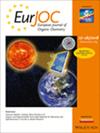Unraveling Phenanthrenoid Dimerization in Juncus acutus: A DFT‐Guided Exploration of Radical‐Coupling Reaction Mechanisms
IF 2.5
3区 化学
Q2 CHEMISTRY, ORGANIC
引用次数: 0
Abstract
Juncus acutus is a plant found near ponds and brackish marshes, producing secondary metabolites like phenanthrenoid dimers with antibacterial, antioxidant, and anti‐inflammatory activities. Despite this, little is known about the detailed mechanisms behind their dimerization reactions. In this study, we used Density Functional Theory to explore the reaction mechanisms of phenanthrene and dihydrophenanthrene species in radical coupling, both in gas‐phase and in solution. The dimerization reactions, initiated by the OH radical, result in the formation of two phenanthrenoid dimers (homodimer and heterodimer). The OH radical abstracts a hydrogen atom from the hydroxyl group, leading to the formation of radicals and water. Our analysis of electronic spin density highlighted the preferred reactive sites that drive regioselective dimer formation. Furthermore, the study identifies a triplet π‐π stacked intermediate preceding the diketone formation on the singlet potential energy surface, revealing a two‐state reactivity mechanism. The diketone dimers are then converted via a water‐mediated keto‐enol tautomerization into their dienolic forms, completing the reaction pathway. This work offers insights into the complex dimerization processes of phenanthrenoids in nature, using computational methods to shed light on poorly understood molecular mechanisms in plant organisms.

尖茎中类菲二聚化的揭示:DFT引导下自由基偶联反应机制的探索
仙人掌属植物是一种生长在池塘和咸淡沼泽附近的植物,其产生的次生代谢物如类菲二聚体具有抗菌、抗氧化和抗炎活性。尽管如此,人们对它们二聚化反应背后的详细机制知之甚少。在本研究中,我们利用密度泛函理论探讨了菲和二氢菲在气相和溶液中自由基偶联的反应机理。由OH自由基引发的二聚化反应导致形成两种类菲二聚体(同二聚体和异二聚体)。OH自由基从羟基上抽离一个氢原子,导致自由基和水的形成。我们对电子自旋密度的分析强调了驱动区域选择性二聚体形成的首选反应位点。此外,该研究还在单线态势能表面发现了在二酮形成之前的三重态π‐π堆叠中间体,揭示了双态反应机制。然后,二酮二聚体通过水介导的酮烯醇互变异构转化为二烯醇形式,完成反应途径。这项工作提供了对自然界中类菲的复杂二聚化过程的见解,使用计算方法来阐明植物生物中鲜为人知的分子机制。
本文章由计算机程序翻译,如有差异,请以英文原文为准。
求助全文
约1分钟内获得全文
求助全文
来源期刊
CiteScore
5.40
自引率
3.60%
发文量
752
审稿时长
1 months
期刊介绍:
The European Journal of Organic Chemistry (2019 ISI Impact Factor 2.889) publishes Full Papers, Communications, and Minireviews from the entire spectrum of synthetic organic, bioorganic and physical-organic chemistry. It is published on behalf of Chemistry Europe, an association of 16 European chemical societies.
The following journals have been merged to form two leading journals, the European Journal of Organic Chemistry and the European Journal of Inorganic Chemistry:
Liebigs Annalen
Bulletin des Sociétés Chimiques Belges
Bulletin de la Société Chimique de France
Gazzetta Chimica Italiana
Recueil des Travaux Chimiques des Pays-Bas
Anales de Química
Chimika Chronika
Revista Portuguesa de Química
ACH—Models in Chemistry
Polish Journal of Chemistry.

 求助内容:
求助内容: 应助结果提醒方式:
应助结果提醒方式:


